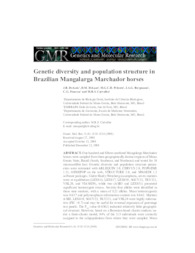Genetic diversity and population structure in Brazilian Mangalarga Marchador horses.
Genetic diversity and population structure in Brazilian Mangalarga Marchador horses.
Author(s): ASSIS, J. B. de; LAAT, D. M. de; PEIXOTO, M. G. C. D.; BERGMANN, J. A. G.; FONSECA, C. G.; CARVALHO, M. R. S.
Summary: One hundred and fifteen unrelated Mangalarga Marchador horses were sampled from three geographically distinct regions of Minas Gerais State, Brazil (South, Southeast, and Northeast) and tested for 10 microsatellite loci. Genetic diversity and population structure parameters were estimated with ARLEQUIN 3.0, CERVUS 2.0, POPGENE 1.31, GENEPOP on the web, STRUCTURE 2.0, and SPAGEDI 1.2 software packages. Under Hardy-Weinberg assumptions, seven markers were at equilibrium (LEX014, LEX017, LEX019, SGCV23, TKY321, VHL20, and VIASH39), while two (ASB3 and LEX031) presented significant homozygote excess. Seventy-four alleles were identified in these nine markers, with a mean of 8.22 alleles. Mean heterozygosity was 0.637 and polymorphism information content was 0.662. Markers ASB3, LEX019, SGCV23, TKY321, and VHL20 were highly informative (PIC >0.7) and may be useful for eventual expansion of parentage test panels. The F(ST) value (0.0562) indicated relatively little geographical structure. However, based on a Bayesian-based cluster analysis under a three-cluster model, 94% of the 115 individuals were correctly assigned to the subpopulations from where they were sampled. Mean pairwise f was relatively high (0.11), and in spite of the efforts towards non-consanguineous sampling, 1% of the pairs of individuals shared over 50% of the alleles. These results strongly suggest that the population is genetically structured. Under a conservation genetics approach, two strategies are recommended: avoidance of crosses between highly endogamic individuals and stimulation of crosses between individuals from those regions for which low genetic flow was identified.
Publication year: 2009
Types of publication: Journal article
Unit: Embrapa Dairy Cattle
Observation
Some of Embrapa's publications are published as ePub files. To read them, use or download one of the following free software options to your computer or mobile device. Android: Google Play Books; IOS: iBooks; Windows and Linux: Calibre.
Access other publications
Access the Agricultural Research Database (BDPA) to consult Embrapa's full library collection and records.
Visit Embrapa Bookstore to purchase books and other publications sold by Embrapa.

